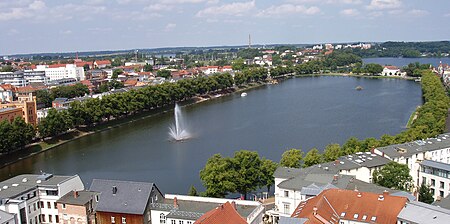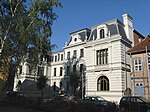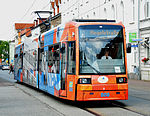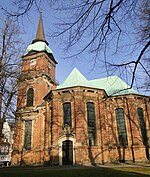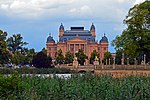Schwerin (German: [ʃveˈʁiːn] (listen); Mecklenburgisch-Vorpommersch Low German: Swerin; Latin: Suerina, Suerinum) is the capital and second-largest city of the northeastern German state of Mecklenburg-Vorpommern as well as of the region of Mecklenburg, after Rostock. It has around 96,000 inhabitants, and is thus the least populous of all German state capitals.
Schwerin is located on the southwestern shore of Lake Schwerin (Schweriner See), the second-largest lake of the Mecklenburg Lake Plateau after the Müritz, and there are eleven other lakes within Schwerin's city limits. The city is surrounded by the district of Northwestern Mecklenburg to the north, and the district of Ludwigslust-Parchim to the south. Schwerin and the two surrounding districts form the eastern outskirts of the Hamburg Metropolitan Region. The name of the city is of Slavic origin, deriving from the root "zvěŕ" (wild animal) or "zvěŕin" (game reserve, animal garden, stud farm).
Schwerin was first mentioned in 1018 as Zuarina and was granted city rights in 1160 by Henry the Lion, thus it is the oldest city of Mecklenburg-Vorpommern. As main residence of the House of Mecklenburg, a dynasty with Slavic roots also known as the Obotrites or Niklotides, Schwerin was the capital of the Duchy of Mecklenburg-Schwerin from 1379 to 1815, of the Grand Duchy of Mecklenburg-Schwerin (after the duke was elevated to the title of a grand duke) from 1815 to 1918, of the Free State of Mecklenburg-Schwerin from 1918 to 1934, of the State of Mecklenburg (after it was merged with the Free State of Mecklenburg-Strelitz) from 1934 to 1952, and of the District of Schwerin from 1952 to 1990.
The romantic Schwerin Palace, situated on Castle Island between Lake Schwerin and Castle Lake, known for its golden dome, the Castle Church, the throne room, and the Niklot statue, used to be the seat of the dukes and grand dukes of Mecklenburg-Schwerin, and since 1990, it is the seat of the state parliament of Mecklenburg-Vorpommern. Schwerin's silhouette is completed by the towers of Schwerin Cathedral, St Paul's Church and St Nicholas' Church. Because of only minor damage in World War II, the city has a largely intact building structure, both in the Altstadt (Old Town) and Schelfstadt (Reed City) quarters.
Major industries and employers include high technology, machine building, healthcare, government agencies, railway supply, consumer goods and tourism. Schwerin has two academic colleges, the Schwerin campus of the "Fachhochschule des Mittelstands" (University of Applied Sciences of the Mittelstand), and the Schwerin campus of the "Hochschule der Bundesagentur für Arbeit" (University of the Federal Employment Agency). There is a regional airport in Parchim, southeast of the city, while Hamburg Airport serves as the city's main airport.
